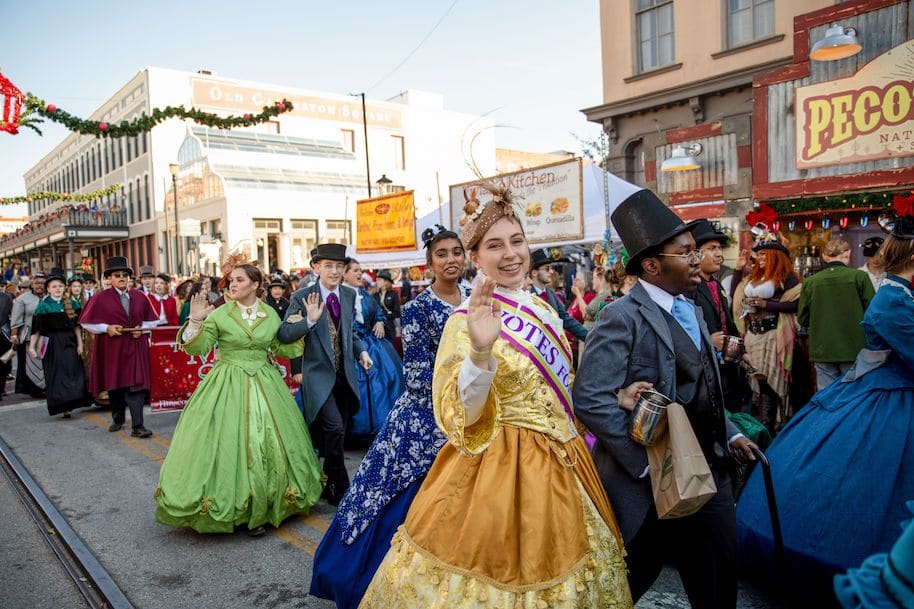
Galveston residents dress up in their Victorian best for the “Dickens on the Strand” celebration now in its 48th year. Photo by Visit Galveston
By Mira Temkin
Mother Nature has pummeled Galveston repeatedly since 1900, but the Gulf Coast city has always bounced back. Walk the cobbled streets of the East End Historic District and you’ll feel the Texas history that begins 200 years ago when Galveston was a pirate kingdom called “Campeche” ruled by French buccaneer Jean Lafitte.
Founded formally in 1839, three years after Texas became a Republic, Galveston quickly became a major immigration center for Europeans heading for the American Southwest. After the Texas Republic entered the Union in 1846 Galveston’s growth increased dramatically. It had the first gas lights in Texas, the first opera house, the first telephone, the first Roman Catholic Cathedral and the first electric lights. By the close of the 19th century, it was a major entrepôt known as the “Ellis Island of the West” that competed with New Orleans.
Storm of the Century
The 20th century was less than a year old when a weather event still known as The Great Storm of 1900 hit Galveston hard, taking more than 8,000 lives and leaving the city in ruins. Today it still remains the worst natural disaster in American history.
Galveston immediately began rebuilding. By 1902 the city completed the first segment of a 17-ft. high seawall that eventually extended ten miles along the coast. Additional sand dredged from ship channels raised the elevation of the entire island.

Destruction caused by the Great Galveston Storm of September 1900. After 122 years the storm remains the largest natural disaster in North American history. Photo courtesy of Visit Galveston
These strategic engineering efforts helped protect the city from total devastation again. But with its coastal location, Galveston frequently endures — Hurricane Rita in 2005, Hurricane Ike in 2008 and Hurricane Imelda in 2019 — major storms and floods.
Enjoying the Present while Protecting the Past
Today, Galveston welcomes visitors to her celebrated port with one of the largest assortments of Victorian architecture in the country plus two historic hotels that remain steeped in island lore. Opened in 1911, the Hotel Galvez was named for Bernardo de Galvez, the Spanish Revolutionary war hero. Now called the Grand Galvez Resort & Spa, the 110-year old building has been repainted in fresh pink coral, reminiscent of earlier days when paint was mixed with seashells giving an iridescent glow.
“We are taking the hotel back to its roots to when the original hotel was built,” says Shane Swope, Director of Operations at the Grand Galvez. “The lobby décor will resemble a train station from 1911 with high-backed, circular chair groupings.
The interior will feature black and white marble flooring along Peacock Alley, a grand walkway with elegant chandeliers, lush burgundy carpets and intricate iron detailing.

Strut your stuff on Peacock Alley at the Grand Galvez Resort and Spa Photo courtesy of Grand Galvez Resort and Spa
“Back in the day, women would strut down the walkway with their long gowns, holding them up much like a peacock would show their feathers,” Swope winks. “Wild peacocks are indigenous to the island and we’re floating around some ideas to incorporate them into the décor.”
The second hotel, The Tremont House, brings a touch of luxury to The Strand National Historic Landmark District located close to the city’s downtown harbor and cruise terminal. The Strand features shops, museums, art galleries and restaurants. In operation for 48 years, the popular Christmas Festival, “Dickens on the Strand,” celebrates the town’s Victorian influence with costumed interpreters, parades and holiday-inspired food.
Gals, Gunsels and Gambling
Galveston was the “Las Vegas of the South” before there was a Las Vegas. Luxurious, casinos built by Bugsy Siegal, John Roselli and Moe Dalitz that lined “The Strip” were built with revenues earned illegally in Galveston bars and bordellos. During the three decades from 1920 to 1950, Galveston was an “open city” and no place was more popular than the Galvez Hotel which hosted entertainers like Frank Sinatra, Bob Hope, George Burns, The Marx Brothers and other top acts of the day. They performed at the members-only Balinese Room in front of patrons that included Howard Hughes, Sophie Tucker and wealthy oil barons from nearby Houston.
Located on a pier jutting 600 feet out into the Gulf of Mexico, the Balinese Room was perfect for adult activities since all sorts of illegal “stuff” could be dumped into the Gulf.
Police raids were infrequent since the mob had friends in local government. On those occasions when Texas Rangers arrived a bell would alert the casino band, which immediately began playing “The Eyes of Texas are upon you.” By the time Rangers arrived at the far end of the pier, guests would be playing bingo.
Called before the Texas Legislature to testify why the club remained open despite its illegal activities, the Galveston County sheriff explained that he wasn’t a member of the private club so he couldn’t get in.
When Franklin Met Lyndon
For over a century the Galvez has been the place to stay in Galveston. During a 10-day offshore fishing trip in 1937, Franklin D. Roosevelt used the hotel as a temporary White House replete with secretaries, Secret Service men, and other officials. He also met here with a newly elected Texas Congressman named Lyndon B. Johnson. Presidents Dwight Eisenhower and Richard Nixon chose the Galvez when they came to Galveston. The Galvez is also a favorite getaway for celebrities, including Beyonce and Jay Z.
Dine at the Grand Galvez Bar & Grill inside the hotel, serving up the freshest Gulf Coast seafood direct from Galveston’s Pier 19. Listed in the National Register of Historic Places, Pier 19 remains a working waterfront with commercial fishery and charter fishing boats. The restaurant also features savory gumbo, “Messy Nachos” and roasted cauliflower tacos. Enjoy breakfast, lunch and dinner at this dining hot spot as you overlook the changing tides of the Gulf.
Buffalo Bill and Clara Barton Slept Here
Located in the heart of The Strand, the original Tremont House dates back to Galveston’s founding. Guests here enjoy luxury accommodations in 119-rooms with 14’ high ceilings, hardwood floors, and custom-crafted furnishings. “The 1920 Art Deco design, combined with Victorian charm and the scent of fig, orange and citrus wafting from air vents throughout the hotel, evokes a sense of well-being,” says General Manager Jeffrey Ossenkop.
The magnificently carved long bar in the Tremont’s Toujouse Lobby once served wealthy imbibers attending Galveston’s Grand 1894 Opera House. A saloonkeeper named Toujouse bought and moved the long bar to his cafe which miraculously survived the 1900 storm. Toujouse thanked the divine for his survival by restoring the bar to its former grandeur. Toujouse prospered, perhaps from divine intervention, and his bar eventually was claimed by the Galveston Historical Foundation. The bar now resides, courtesy of the foundation, at the Tremont House where it continues to serve guests, as does the Opera House, which still is used as a performing arts center.
“Guests get an authentic sense of history and slice of Southern hospitality at the hotel,” said Ossenkop. “The downtown district is very different than the beach, welcoming everyone in a friendly, laid-back atmosphere. In addition, there’s a great deal of music, art and culture, all within a small radius.”
As you wander around the Tremont admire the stately antiques from a bygone era like the grandfather clock in the lobby or a majestically- carved armoire on the top floor.
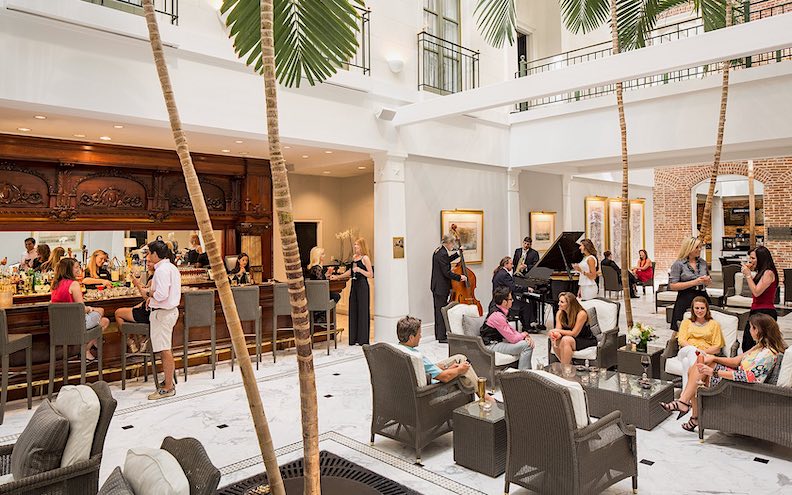
Try one of the Prohibition-era cocktails like the New York Sour at the Toujouse Lobby Bar in The Tremont House. The long bar on the left has the most interesting story in the room. Photo courtesy of The Tremont House
Says Ossenkop: “We offer the only rooftop bar in Galveston, which provides great views of downtown and the harbor. With warming fire pits, great cocktails and tasty snacks, this is one of the most popular bars on the island for visitors and locals alike.” He recommends the Charcuterie Plate featuring Texas Cheeses or flatbreads and paninis.
Famous guests of the hotel include Presidents: Rutherford Hayes, Ulysses Grant, Grover Cleveland, Benjamin Harrison, James Garfield, and Chester Arthur. Other luminaries include Buffalo Bill Cody, Lilly Tomlinson and Hal Halbrook. After the Great Storm, Clara Barton took refuge in the hotel as she helped disaster victims.
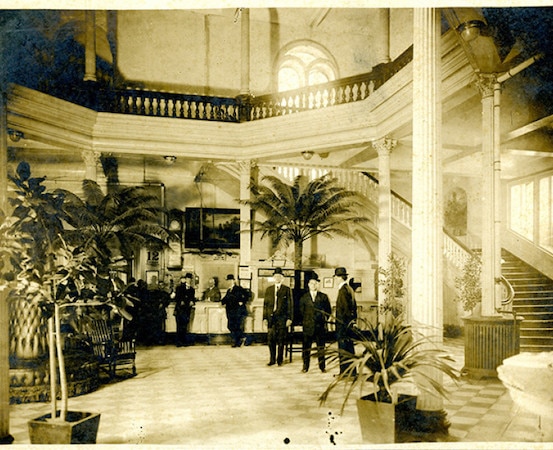
As it is today, the Tremont House in 1872 was a social focus for Galveston’s prosperous entrepreneurs. Despite being a major port for the export of cotton, Galveston suffered relatively little damage in the Civil War. Photo courtesy of The Tremont House
Hotel Spirits Won’t Give up the Ghost
With all of the natural disasters that have befallen the island, it’s no wonder that Galveston offers ghost hunters many paranormal experiences.
The Grand Galvez’s most famous ghost tale happened in the 1950s when “Audra, the Lovelorn Lady,” after learning her fiancée was lost at sea ,hung herself in room 501. Unfortunately, she was misinformed. When Audra’s seafaring groom returned to Galveston, he found his Juliet in the grave. As you might expect, Audra is still angry. Her spirit continues to visit the hotel by slamming doors, flashing spooky lights and turning TVs on and off without explanation.
When Audra takes a break, some say the ghosts of children, who perished in the 1900 storm make an appearance.
At the Tremont House, guests report flickering lights, opening and closing drapes and visions of a boy named Jimmy who hangs out at the front desk. The hotel was used as a morgue during the Great Storm and some of these lost souls never passed over.
Tremont’s most popular spirit is the “Civil War Soldier” who marches through the hotel, armed and ready for battle. Guests report hearing the clacking of his boots as he continues to defend The Tremont. The Strand experienced so many tragedies, ghosts seem to lurk in the shadows and alleys, not willing to let go.
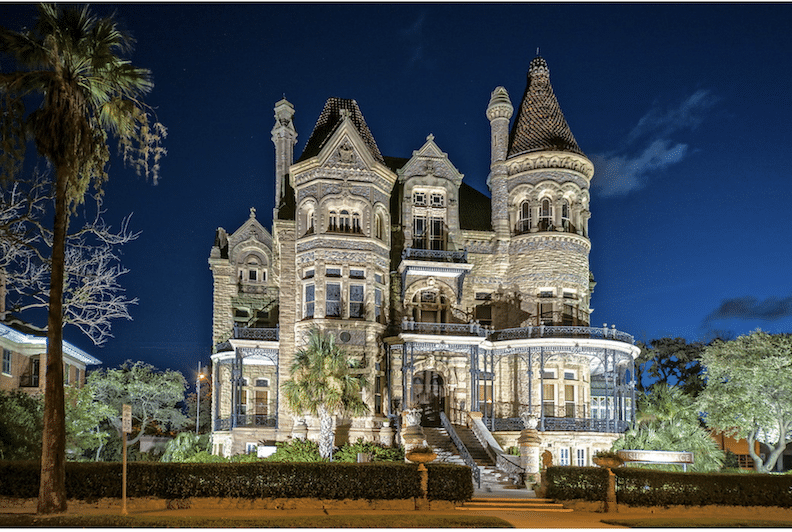
The Bishop’s Palace is featured on Galveston’s ghost tour. The building’s regal exterior hides stories best told during the dead of night. Photo by Visit Galveston
Tours and Museums Reveal Galveston History
Want to meet an apparition? Then try one of Galveston’s Ghost Tours. These walking excursions take you through cemeteries, the Strand and other spooky areas as you hear haunting stories from the past.
After a 2.5 million upgrade, the Historic Texas Seaport Museum has reopened at the port of Galveston with a new Ship to Shore Exhibit that traces immigrant experiences. Visitors get to follow in the footsteps of early immigrants who arrived in Galveston in the 1880s with a digital card that personalizes their journey. Featuring authentic stories and documents, visitors come to better understand the immigrant experience.
Dine in Historic Places
Many historic buildings have been repurposed as shops, art galleries and cafes. The Galveston Restaurant Group has several restaurants housed in historic buildings on Post Office Street, including Taquilo’s, Gumbo Bar and Sky Steak & Sushi. The buildings once housed banks, commercial goods and retail stores.
Marine Guy Taylor lived above Taquilo’s and out of respect to his buddy lost in the Korean War, played taps at sunset every night from his balcony. Since Taylor died in 2017, Constable Clint Brown has taken over the honor, stopping traffic and playing tribute to Taylor and to all who have proudly served.
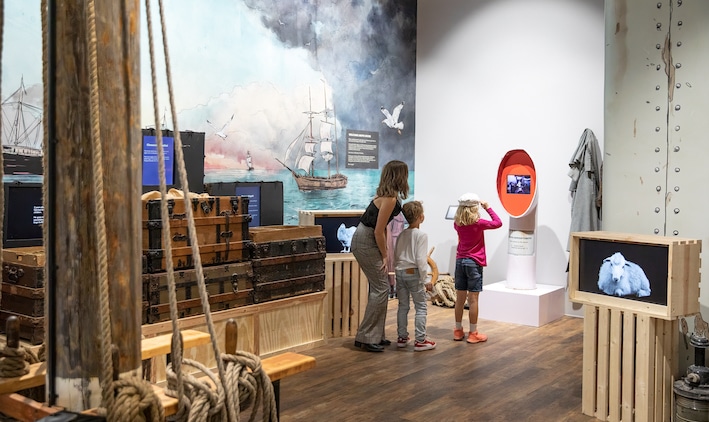
The Ship to Shore Exhibit in the Galveston Texas Seaport Museum presents the city’s past in a colorful way that entertains both parents and children. Photo courtesy of Texas Seaport Museum
Slurp an ice cream soda at the soda fountain counter in Star Drugs, the oldest drugstore in Texas. Opened in 1890, Star Drugs was also the first desegregated lunch counter in Galveston. Oh yeah, you can still buy a bottle of aspirin there.
You’ll quickly learn the local lingo that separates the islanders. BOI means “Born on the Island,” said with great pride, while IBC signifies “Islander by Choice” and happy to be here.
From a long history of natural disasters to its present-day status as a popular cruise terminal/vacation destination, Galveston Island continues to share its stories and create a new golden era. ![]()
For more information on Galveston Island, go to Visit Galveston
Mira Temkin is a Chicago-based travel writer with a thirst for adventure, a love of legends and an appetite for juicy steaks.


1 Comment